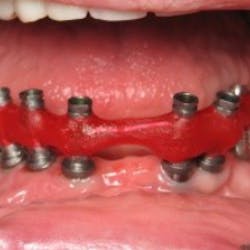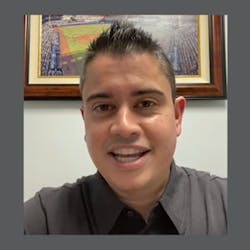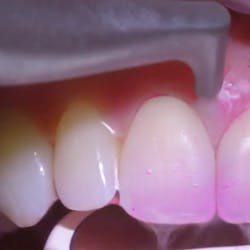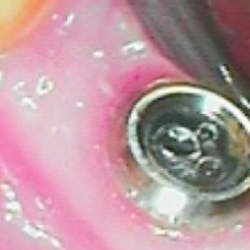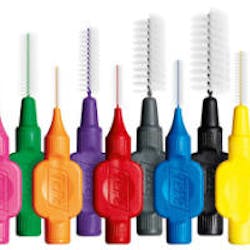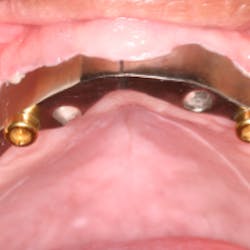By Chris Salierno, DDS
Samuel Low, DDS, (at left) was president of the American Academy of Periodontology in 2009-2010. He serves as professor emeritus of periodontology at the University of Florida with a practice in periodontics, advisory faculty member at the Pankey Institute for Advanced Dental Education, and the American Dental Association's 17th District Trustee.
Dr. Chris Salierno: How has the role of a periodontist as a member of the dental team changed over your career, and why has it changed?Dr. Samuel Low: The major change for periodontists over the past 30 years has been the move from comprehensive care periodontics to more prescription-based periodontics. Instead of managing periodontal disease, periodontal practices are now given prescriptions for implants, implant site preparation, crown lengthening, and perio plastic surgery.Dr. Salierno: So is the comprehensive management of periodontal disease being managed by the general dentist, not being diagnosed as much, or both?Dr. Low: Both. As a periodontist, I feel very confident with the referring dentist managing Phase 1, nonsurgical periodontal care when it’s at the level that’s considered to be the standard. And that has changed. Twenty years ago, no periodontist would ever suggest the notion. The norm was periodontitis discovered in the general practice and then referred immediately for specialty care. When one has had a quality cadre of referring dentists, you educate their hygienists and trust them to evaluate if there are additional needs beyond Phase 1.Dr. Salierno: Why do you think that has changed?Dr. Low: First, when there is an economic lull, dentists decrease referrals to specialists. They undertake procedures that they normally would not do and seek the respective continuing education. The difference with periodontal care is that these treatment modalities can be shifted to the hygienist. If general dentists are not busy, they may take a course in advanced endodontics. But as soon as they’re busy again, they may return to referring out difficult cases. But in periodontics, once general dentists learn they can manage the case by referring to their hygienist, they may still refer to the hygienist even when they get busy again. And this is acceptable if a standard of care is maintained and periodontitis is managed at a competent level. The second reason is more complex. General dentists do not have an endodontic, oral surgery, or orthodontic hygienist they can refer to. But in some ways, hygienists can be like periodontal mid-level providers in a practice, especially when they may not be supervised. Dr. Salierno: What should dental schools and graduate residency programs do to teach students about the team approach to comprehensive treatment?Dr. Low: The Commission on Dental Accreditation Standard on Referral has to be improved upon to suggest competency in referral patterns and building relationships. The postdoctoral and predoctoral groups should come together to mimic the positive relationships we experience in private practice.Dr. Salierno: Are you suggesting that postdoctoral residents should solicit business from general practice residents and dental students, or is that going too far?Dr. Low: The scenario you suggest exists now behind the scenes. One may see residents receiving cases from other residents and students based upon relationships; perhaps they’re friends or are in the same dental fraternity. Those patterns exist in schools; they’re just not financially motivated. Referral relationships need to be fostered and built.In closing, graduate programs need to share the scope of their specialty with predoctoral students. This includes multirooted endodontics, orthodontic treatment; periodontal procedures should be experienced beyond a few didactic lectures. Periodontal departments should desire to have dental students appreciate the scope of periodontics beyond “periodontal charting and scaling and root planing” if our intent is to build the referral relationship.
Dr. Chris Salierno: How has the role of a periodontist as a member of the dental team changed over your career, and why has it changed?Dr. Samuel Low: The major change for periodontists over the past 30 years has been the move from comprehensive care periodontics to more prescription-based periodontics. Instead of managing periodontal disease, periodontal practices are now given prescriptions for implants, implant site preparation, crown lengthening, and perio plastic surgery.Dr. Salierno: So is the comprehensive management of periodontal disease being managed by the general dentist, not being diagnosed as much, or both?Dr. Low: Both. As a periodontist, I feel very confident with the referring dentist managing Phase 1, nonsurgical periodontal care when it’s at the level that’s considered to be the standard. And that has changed. Twenty years ago, no periodontist would ever suggest the notion. The norm was periodontitis discovered in the general practice and then referred immediately for specialty care. When one has had a quality cadre of referring dentists, you educate their hygienists and trust them to evaluate if there are additional needs beyond Phase 1.Dr. Salierno: Why do you think that has changed?Dr. Low: First, when there is an economic lull, dentists decrease referrals to specialists. They undertake procedures that they normally would not do and seek the respective continuing education. The difference with periodontal care is that these treatment modalities can be shifted to the hygienist. If general dentists are not busy, they may take a course in advanced endodontics. But as soon as they’re busy again, they may return to referring out difficult cases. But in periodontics, once general dentists learn they can manage the case by referring to their hygienist, they may still refer to the hygienist even when they get busy again. And this is acceptable if a standard of care is maintained and periodontitis is managed at a competent level. The second reason is more complex. General dentists do not have an endodontic, oral surgery, or orthodontic hygienist they can refer to. But in some ways, hygienists can be like periodontal mid-level providers in a practice, especially when they may not be supervised. Dr. Salierno: What should dental schools and graduate residency programs do to teach students about the team approach to comprehensive treatment?Dr. Low: The Commission on Dental Accreditation Standard on Referral has to be improved upon to suggest competency in referral patterns and building relationships. The postdoctoral and predoctoral groups should come together to mimic the positive relationships we experience in private practice.Dr. Salierno: Are you suggesting that postdoctoral residents should solicit business from general practice residents and dental students, or is that going too far?Dr. Low: The scenario you suggest exists now behind the scenes. One may see residents receiving cases from other residents and students based upon relationships; perhaps they’re friends or are in the same dental fraternity. Those patterns exist in schools; they’re just not financially motivated. Referral relationships need to be fostered and built.In closing, graduate programs need to share the scope of their specialty with predoctoral students. This includes multirooted endodontics, orthodontic treatment; periodontal procedures should be experienced beyond a few didactic lectures. Periodontal departments should desire to have dental students appreciate the scope of periodontics beyond “periodontal charting and scaling and root planing” if our intent is to build the referral relationship.


